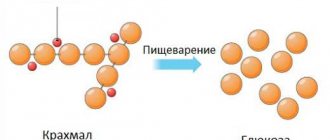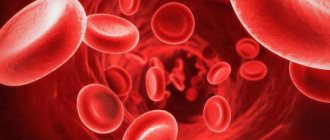7101 02 December
IMPORTANT!
The information in this section cannot be used for self-diagnosis and self-treatment.
In case of pain or other exacerbation of the disease, diagnostic tests should be prescribed only by the attending physician. To make a diagnosis and properly prescribe treatment, you should contact your doctor. We remind you that independent interpretation of the results is unacceptable; the information below is for reference only.
Beta-2-microglobulin (in blood): indications for use, rules for preparing for the test, interpretation of results and normal indicators.
Indications for prescribing the study
Beta-2 microglobulin (Beta-2 microglobulinserum, BMG) is a protein that is found on the surface of almost all cells in the human body.
The study of beta-2-microglobulin in the blood is prescribed for kidney diseases, for patients on dialysis to assess the risk of developing amyloidosis (deposition of pathological proteins in organs and tissues), to identify early signs of kidney rejection after transplantation. Beta-2-microglobulin is often elevated in the blood in cancers such as multiple myeloma (a tumor of the blood cells (lymphocytes) that destroys bones), lymphoma (a tumor that primarily affects the lymph nodes), and leukemia (blood cancer).
Blood test for alpha-2 macroglobulin levels
This test is prescribed during the diagnosis of liver pathologies. In particular, its results help to identify such a pathological process as fibrosis. It has been scientifically proven that an increase in the amount of protein in the blood serum coincides in time with the progression of fibrosis and the transition of inflammation to the active phase. Despite this, today in medical practice the results of laboratory tests are considered only as an indirect sign of pathological degeneration of the liver. An accurate diagnosis is made by a doctor only based on the results of a biopsy. Changes in laboratory parameters may serve as an indication for its implementation. If the blood test results for alpha-2 macroglobulin
in patients with suspected fibrosis remain within normal limits, this allows one to refuse invasive research, which carries certain health risks.
Normal alpha-2 macroglobulin
The age of 1-2 years is characterized by the maximum level of this protein. The norm for children is almost twice as high as for adults. Protein levels gradually decrease as you get older. Older people often experience increased rates. Interpretation of the results is carried out taking into account the age and gender of the patient, as well as a number of other factors.
Indications for the study
This test is carried out in the following cases:
- examination of persons with diagnosed kidney pathologies;
- chronic liver diseases, which can lead to fibrosis and cirrhosis;
- examination of patients with diabetes mellitus, carcinoma or prostate hyperplasia.
Preparing for the study
To carry out the test, you need to donate blood from a vein. She gives up on an empty stomach after a 12-hour fasting break. During this time, you can only drink water. Half an hour before donating blood, you must stop smoking, avoid significant physical activity and stress.
Preparation for the procedure
- It is preferable to wait 4 hours after your last meal.
- On the eve of the study, you should avoid food overload (do not eat too much!).
- Avoid drinking alcohol on the eve of the test.
- Do not smoke for at least 1 hour before the test.
- Try not to overexert yourself physically and emotionally on the eve of the test.
- When studying the concentration of beta-2-microglobulin in the blood over time, it is recommended to conduct repeated studies under the same conditions (donate blood in the same laboratory).
What does it mean if the results are downgraded?
- Albumin - poor nutrition, insufficient absorption of nutrients, liver and kidney diseases, neoplasms, rheumatic diseases, bleeding and burns, excess water consumption, genetic pathologies of protein synthesis, pregnancy;
- Alpha-1 globulin – Tangier disease and genetically determined protein deficiency;
- Alpha-2 globulin – pancreatitis, burns and trauma, hemolysis and sarcoidosis;
- Beta globulin – deficiency of immunoglobulin A (IgA);
- Gamma globulin – decreased immunity, glucocorticoid therapy, plasmapheresis and pregnancy.
Reference values:
| Age | Men, mg/l | Women, mg/l |
| 1 day – 4.3 weeks. | 1,6 – 4,8 | 1,7 – 4,5 |
| 4.3 weeks – 6 months | 1,4– 3,3 | 1,0 – 3,8 |
| 6 months – 12 months | 0,9 – 3,1 | 1,0 – 2,3 |
| Over 1 year old | 0,9 – 2,0 | 0,9 – 2,0 |
Beta-2-microglobulin is present on almost all cells of the body and is released into the blood, especially by beta lymphocytes (blood cells that provide immunity, recognize foreign structures, and synthesize antibodies).
In the human body, beta-2-microglobulin performs important functions:
- provides the process of antigenic presentation (presentation) of a foreign agent to trigger an immune response;
- participates in cell proliferation (cell reproduction by division);
- involved in the process of apoptosis (controlled physiological self-destruction of cells);
- regulates the production of hormones and cell growth factors.
Beta-2-microglobulin is used in clinical practice as a tumor marker for patients with blood cancer (when blood cells degenerate into tumor cells and cease to perform their functions).
Blood beta-2-microglobulin concentrations are used to determine the severity and spread of multiple myeloma and lymphoma. A higher level of beta-2-microglobulin in the blood corresponds to a more advanced stage of the oncological process.
Studying the concentration of beta-2-microglobulin in the blood over time allows us to draw conclusions about the effectiveness of treatment:
- an increase in beta-2-microglobulin levels may mean that the cancer is spreading and therapy is not effective;
- a decrease in beta-2-microglobulin levels indicates a good prognosis and effective treatment;
- A decrease and subsequent increase in beta-2-microglobulin levels indicates that the cancer has recurred after treatment.
Beta-2-microglobulin is present in most body fluids, most in the blood, less in the cerebrospinal fluid, and trace amounts in the urine.
In adults, the production of this protein is relatively constant. Beta-2-microglobulin passes through the glomeruli of the kidneys (structures that filter the blood), and then returns to the lower parts (in the kidney tubules). When the glomeruli of the kidneys are damaged, they cannot filter beta-2-microglobulin and its levels in the blood increase. The study of beta-2-microglobulin in patients with kidney disease is prescribed for differential diagnosis in order to determine which parts of the kidney are damaged.
In people with kidney disease who are on dialysis (a procedure to artificially cleanse the blood of toxins and harmful substances), beta-2-microglobulin can form abnormal structures that are deposited in joints and tissues (dialysis-associated amyloidosis). Therefore, for patients who have been on dialysis for more than five years, it is recommended to determine the level of beta-2-microglobulin for early detection of amyloidosis.
What is globulin?
Globulin is a blood protein important for regulating the functioning of our bodies. Why are globulins needed?
Main functions:
- transport hormones, vitamins and other substances;
- protect the body from viruses, bacteria, toxins, foreign proteins, producing antibodies against them;
- regulate blood clotting;
- bind sex hormones, drugs, carbohydrates and other substances.
The amount of globulins may deviate from the norm in the following cases:
- inflammatory process;
- disturbances in the functioning of the liver, kidneys, lungs, endocrine system;
- hormonal changes;
- physical or chemical damage to organs;
- cancer;
- HIV infection;
- advanced age (in men the concentration of globulins may be increased).
The amount of globulins is regulated by sex hormones: estrogens increase their level, androgens decrease them. Accordingly, women contain more blood globulins than men.
Sex hormone binding globulin
The liver produces most of the blood proteins, including SHBG - sex hormone binding globulin. For the body to function properly, some of the hormones must be bound. The bound hormone is inactive, while the free one is active and performs all its functions. By binding “extra” hormones, protein limits their effect on the body.
SHBG binds progesterone, estradiol, testosterone, androstenedione, 5-dihydrotestosterone. When the amount of SHBG decreases, the concentration of active (free, unbound) hormones increases. With increased amounts of unbound sex hormones, irregular menstrual cycles and facial hair growth (in women), breast enlargement (in men) and other effects may occur.
If you suspect that your globulin is high or low, consult your doctor. He will write a referral for a SHBG analysis. Women can take it on any day of the menstrual cycle.
SHBG: normal
In women of reproductive age, sex hormone binding globulin should be in a concentration of 26.1–110.0 nmol/l.
In postmenopausal women, 14.1–68.9 nmol/l.
In men, their level should be in the range of 14.5–48.4 nmol/l.
Globulin is elevated - possible reasons:
- increased amount of estrogens;
- dysfunction of the endocrine system;
- hepatitis;
- HIV infection;
- taking oral contraceptives.
Reduced SHBG levels are promoted by:
- increased levels of hormones (testosterone, cortisol, prolactin);
- gigantism;
- polycystic ovary syndrome;
- cirrhosis of the liver;
- nephrotic syndrome;
- insufficient amounts of thyroid hormones;
- syndrome of insufficient cellular sensitivity to insulin.
Globulins are a group of proteins that includes several subgroups: alpha 1, alpha 2, beta and gamma. Their number fluctuates during illnesses.
| Body condition | Fractions (groups) of globulins | Examples of diseases | |||
| Alpha-1 | Alpha-2 | Beta | Gamma | ||
| Acute inflammatory processes | ↑ | ↑ | — | ↑ | Acute viral and bacterial diseases, myocardial infarction, early stages of pneumonia, acute polyarthritis, tuberculosis (exudative) |
| Chronic inflammatory processes | — | ↑↑ | — | ↑↑ | Cholecystitis, pyelitis, cystitis, late stages of pneumonia, chronic tuberculosis and endocarditis |
| Renal dysfunction | — | ↑ | ↑ | ↓ | Nephritis, toxicosis during pregnancy, tuberculosis (terminal stages), nephrosclerosis, nephritis, cachexia |
| Malignant neoplasms | ↑↑ | ↑↑ | ↑↑↑ | ↑↑ | Tumors in various organs with metastases |
| Hepatitis | — | — | ↑ | ↑↑ | Liver poisoning, hepatitis, leukemia, oncology of the lymphatic and hematopoietic apparatus, dermatosis, polyarthritis (some forms) |
| Liver necrosis | — | ↓ | ↑ | ↑↑ | Severe forms of tuberculosis, chronic polyarthritis and collagenosis, liver cirrhosis |
| Jaundice (mechanical) | — | ↑ | ↑ | ↑ | Cancer of the biliary tract and head of the pancreas, as well as obstructive jaundice |
↑ - means that the concentration is increasing
↓—means that the concentration decreases
Alpha globulins
Alpha globulins are divided into two categories: alpha 1 globulins and alpha 2 globulins.
Alpha-1-globulins: normal
The normal level of alpha-1-globulins is 3–6%, or 1–3 g/l.
Among alpha-1-globulins there are:
- alpha-1 antitrypsin;
- alpha-1 lipoprotein;
- alpha-1-glycoprotein;
- alpha-1-fetoprotein;
- alpha-1-antichymotrypsin.
These substances are also called acute phase proteins: they are produced in increased quantities during various organ damage (chemical or physical), during viral and bacterial infections. They stop further tissue damage and prevent pathogenic microorganisms from multiplying.
The level of alpha-1-globulins increases with:
- viral and bacterial infection;
- acute and chronic inflammation;
- malignant tumor;
- skin damage (burn, injury);
- poisoning;
- changes in hormonal levels (steroid therapy, pregnancy);
- systemic lupus erythematosus;
- increased body temperature;
- arthritis;
- multiple pregnancy;
- fetal malformations or death.
The level of alpha-1-globulins decreases when the work is disrupted:
- lungs (emphysema);
- liver (cirrhosis, cancer);
- kidney (nephrotic syndrome);
- testicular (cancer) and oncology of other organs.
Alpha-2-globulins: normal
Their concentration normally ranges from 9 to 15% (6–10 g/l).
Among alpha-2-globulins there are:
- alpha-2-macroglobulin;
- haptoglobin;
- ceruloplasmin;
- antiotensinogen;
- alpha-2-glycoprotein;
- alpha-2-HS-glycoprotein;
- alpha-2-antiplasmin;
- protein A.
Among the substances in this group there are acute phase proteins, as well as transport proteins.
The amount of alpha-2-globulins increases with:
- liver damage (cirrhosis, hepatitis);
- tissue damage (burn, injury);
- inflammation;
- tissue necrosis (death);
- malignant tumors (with metastases);
- endocrine diseases (diabetes mellitus, myxedema);
- changes in hormonal levels (treatment with steroid hormones, pregnancy);
- jaundice;
- autoimmune disease;
- impairment of kidney function (nephrotic syndrome).
The concentration of alpha-2-globulins can be reduced by:
- insufficient amount of protein in food;
- rheumatic arthritis;
- anemia;
- diseases of the gastrointestinal tract;
- malnutrition;
- malabsorption in the intestine.
Beta globulins
With a sufficient level of beta globulins, their concentration should be in the range of 8–18% (7–11 g/l).
In the category of beta globulins there are:
- hemopexin;
- transferrin;
- steroid-binding beta globulin;
- beta and prebeta lipoproteins.
Most beta globulins are transport proteins.
Beta globulins increase with:
- iron deficiency;
- taking hormonal contraceptives;
- pregnancy;
- diabetes mellitus;
- dystrophy;
- elevated estrogen levels.
Reduced levels of beta globulins - causes:
- inflammation:
- malignant tumor;
- anemia;
- liver disease;
- insufficient amount of protein in food;
- nephrotic syndrome;
- increased levels of hormones (testosterone, prolactin, glucocorticoids);
- syndrome of insufficient cell sensitivity to insulin;
- disturbances in the functioning of the pituitary gland;
- dysfunction of the endocrine system.
Gamma globulins
If the body functions correctly and secretes gamma globulins, their norm should be in the range of 15–25% (8–16 g/l). This group of proteins includes protective proteins - immunoglobulins (Ig). They are often called antibodies. Among them are:
- immunoglobulins G (IgG) - protect against viruses and bacteria. They are transferred in large quantities through the placenta.
- immunoglobulins A (IgA) - protect the mucous surfaces of the respiratory system and intestines. Found in saliva, tears, and female colostrum.
- immunoglobulins M (IgM) - provide primary immunity: after birth and up to 9 months, their number increases and then decreases. Recovered after 20 years.
- immunoglobulins E (IgE) - produce antibodies to allergens.
- immunoglobulins D (IgD) - regulate the work of other immunoglobulins.
Among the immunoglobulins, a group of cryoglobulins is also distinguished. These proteins dissolve when heated and precipitate when the blood serum is cooled. Healthy people don't have them. Most often they appear in rheumatoid arthritis and multiple myeloma, viral hepatitis B and C, autoimmune and other diseases.
An elevated level of gamma globulins is called hypergammaglobulinemia. It is observed when immune processes are strengthened. The reasons why gamma globulins increase may be:
- acute and chronic infectious blood disease;
- some tumors;
- hepatitis and cirrhosis of the liver.
Gamma globulins may be present in low concentrations when:
- weak immunity;
- chronic inflammatory process;
- allergic reaction;
- long-term treatment with steroid hormones;
- AIDS.
If a person has had a certain disease, then antibodies to this disease - gamma globulins - can be extracted from his blood. In addition, they can be obtained from animal blood. To do this, animals (most often horses) are first given a special vaccine.
For prevention and treatment, it is recommended to administer gamma globulins immediately after contact with an infected patient or in the early stages of the disease. This is especially effective in the first two days of illness.
When a person has gamma globulins in his blood, the disease goes away faster and the likelihood of complications is reduced. To date, gamma globulins have been isolated against influenza, dysentery, infectious hepatitis, tick-borne encephalitis, whooping cough, measles, rubella, smallpox, mumps, anthrax and scarlet fever.
In the first six months of a child’s life, mother’s gamma globulins protect him from diseases.
Reasons for increased levels of beta-2-microglobulin in the blood:
- inflammatory process in the body;
- autoimmune disorders (including systemic lupus erythematosus, Sjogren's syndrome, rheumatoid arthritis), when the immune system mistakenly attacks its own cells;
- blood cancer - multiple myeloma, B-cell chronic lymphocytic leukemia, non-Hodgkin's lymphoma, Hodgkin's disease;
- viral infections (HIV, cytomegalovirus infection, infectious mononucleosis, etc.);
- renal failure;
- kidney transplant rejection;
- in patients on hemodialysis.
Indications
- Determination of different types of blood cell cancer;
- Differential diagnosis of tubular and glomerular kidney pathologies;
- Diagnosis and treatment of chronic renal failure;
- Determining the stage and form of the myeloma process, assessing the effectiveness of treatment, identifying the size of the tumor mass;
- Forecast for the development of other cancers: lymphoma, leukemia, etc.;
- Monitoring the patient's condition after a kidney transplant (to determine the rejection reaction);
- Therapy for patients who were in contact with mercury and cadmium concentrates, were intoxicated with chemicals, drugs, alcohol, or were exposed to radiation;
- Assessment of the state of the central nervous system against the background of any oncological pathologies, AIDS;
- Diagnosis of diseases of the lymphatic system, which are accompanied by activation of immune reactions (multiple sclerosis);
- Diagnosis and treatment of severe viral infections (cytomegalovirus, HIV, etc.);
- Monitoring the course and treatment of autoimmune diseases.
The test for beta-2 microglobulin in the blood can be interpreted by an oncologist, transplant surgeon, nephrologist and therapist.
Reasons for the decrease in beta-2-microglobulin in the blood over time:
- effective cancer treatment.
Sources:
- Drueke TB, Massy ZA. Beta2-microglobulin. Semin Dial 2009; 22: 378–380.
- ChanghoonYoo, Dok Hyun Yoon, Cheolwon Suh.Serum beta-2 microglobulin in malignant lymphomas: an old but powerful prognostic factor. Blood Res. – 2014.
- Burtis CA, Bruns DE. Tietz Fundamentals of Clinical Chemistry and Molecular Diagnostics, seventh edition, 2015; 306 p.
- Corlin D, Heegaard N (2012) β2-Microglobulin Amyloidosis. In: Harris J (eds) Protein Aggregation and Fibrillogenesis in Cerebral and Systemic Amyloid Disease. Subcellular Biochemistry, vol 65. Springer, Dordrecht.
- S. Vincent Rajkumar. Myeloma Today: Disease Definitions and Treatment Advances, Am J Hematol. 2021 Jan; 91(1): 90–100.









